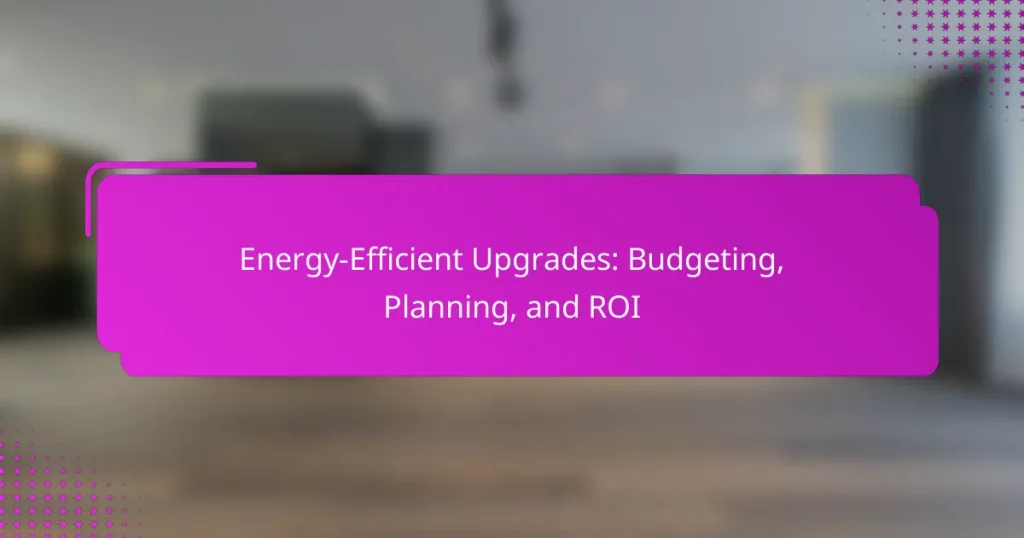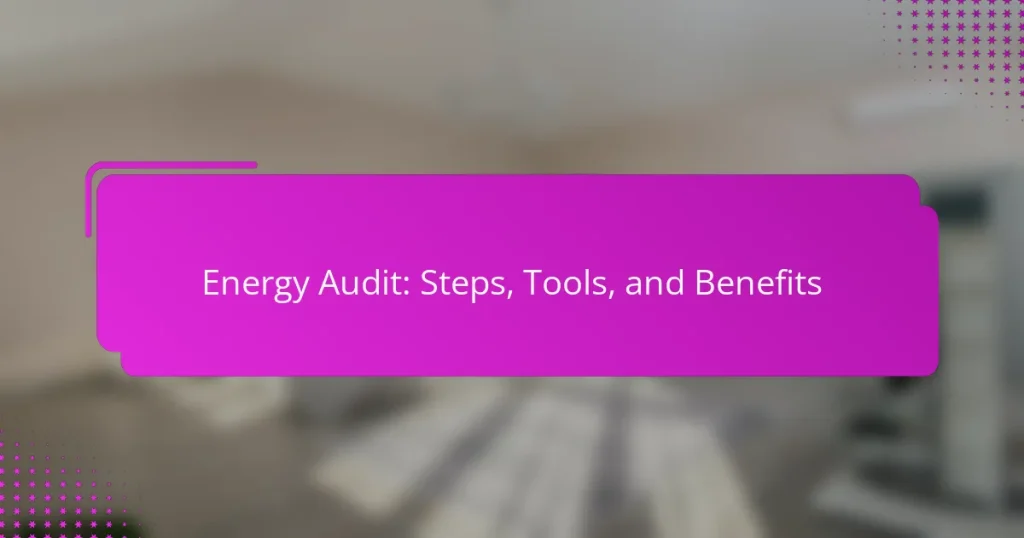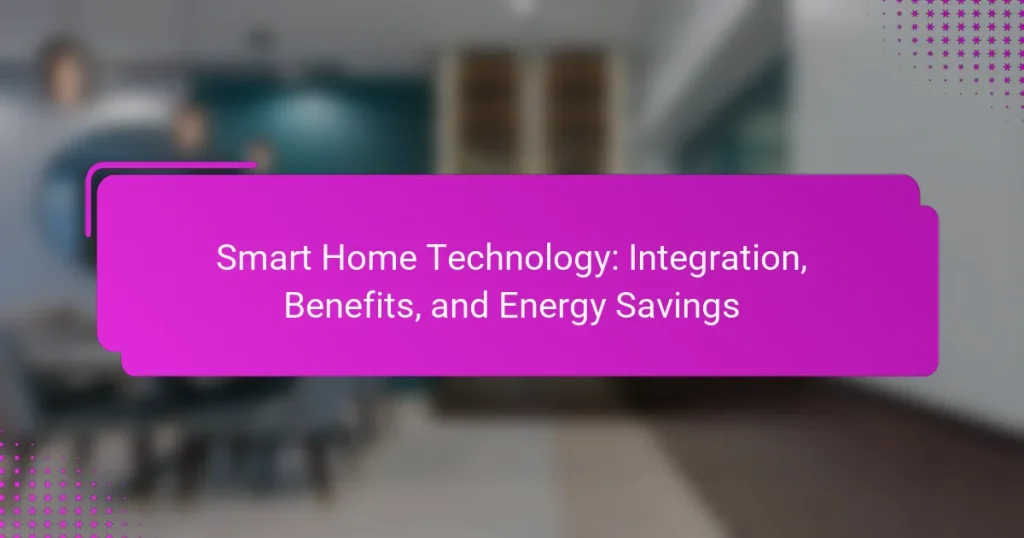Sustainable home design consulting offers valuable insights into energy efficiency strategies that enhance comfort while minimizing energy consumption. By incorporating techniques such as passive solar design, high-performance insulation, and smart home technology, homeowners can create spaces that are both functional and environmentally friendly. Selecting the right consultant involves evaluating their qualifications and experience to ensure a successful project outcome.
Energy-Efficient Appliances: Selection Criteria and Benefits
Energy Efficiency Strategies: Proven Methods, Smart Technology, and Budgeting
Solar Panel Options: Types, Costs, and Efficiency
Energy Audit: Steps, Tools, and Benefits
Smart Home Technology: Integration, Benefits, and Energy Savings
Energy Star Ratings: Standards, Benefits, and Compliance
What are the best energy efficiency strategies for sustainable home design?
The best energy efficiency strategies for sustainable home design focus on reducing energy consumption while maximizing comfort and functionality. Key approaches include passive solar design, high-performance insulation, energy-efficient windows, smart home technology, and renewable energy systems.
Passive solar design
Passive solar design utilizes the sun’s energy for heating and cooling without mechanical systems. This strategy involves orienting the home to maximize sunlight exposure, incorporating thermal mass materials, and using overhangs to control heat gain during summer months.
Consider using large south-facing windows to capture sunlight in colder seasons while minimizing openings on the north side. This design can significantly reduce heating costs and enhance indoor comfort.
High-performance insulation
High-performance insulation is crucial for maintaining a comfortable indoor environment and reducing energy bills. Materials such as spray foam, cellulose, and rigid foam boards provide superior thermal resistance compared to traditional insulation.
Ensure that insulation is installed correctly, covering all gaps and seams to prevent air leaks. Aim for an R-value appropriate for your climate zone, typically ranging from R-30 to R-60 for attics in colder regions.
Energy-efficient windows
Energy-efficient windows minimize heat loss and gain, contributing to overall energy savings. Look for double or triple-pane windows with low-emissivity (low-E) coatings that reflect heat while allowing natural light.
Consider the window’s U-factor and solar heat gain coefficient (SHGC) to select the best options for your climate. Proper installation is essential to avoid drafts and maximize performance.
Smart home technology
Smart home technology enhances energy efficiency by automating and optimizing energy use. Systems such as programmable thermostats, smart lighting, and energy monitoring devices allow homeowners to manage energy consumption effectively.
Investing in smart devices can lead to significant savings. For example, programmable thermostats can reduce heating and cooling costs by adjusting temperatures based on occupancy patterns.
Renewable energy systems
Incorporating renewable energy systems, such as solar panels or wind turbines, can drastically reduce reliance on fossil fuels and lower energy bills. Solar photovoltaic (PV) systems convert sunlight into electricity, while solar thermal systems can provide hot water.
Evaluate local incentives, such as tax credits or rebates, to offset installation costs. A well-designed renewable energy system can provide a substantial return on investment over time, contributing to a sustainable home.
How can I choose a sustainable home design consultant in California?
To choose a sustainable home design consultant in California, focus on their qualifications, experience, and client feedback. Look for professionals who specialize in energy-efficient design and have a strong portfolio of successful projects.
Check certifications and experience
Verify that the consultant holds relevant certifications, such as LEED (Leadership in Energy and Environmental Design) or similar credentials. These certifications indicate a commitment to sustainable practices and knowledge of current regulations.
Experience is equally important; seek consultants with several years in the field, particularly those who have worked on projects similar to yours. A well-rounded background in sustainable design can enhance the quality of your project.
Review past projects and client testimonials
Examine the consultant’s portfolio to assess the quality and variety of their past projects. Look for examples that showcase energy-efficient designs and innovative solutions tailored to California’s climate.
Client testimonials can provide insight into the consultant’s reliability and effectiveness. Reach out to previous clients if possible to gather firsthand accounts of their experiences and satisfaction with the consultant’s work.
Evaluate communication and collaboration skills
Effective communication is crucial in the design process. Ensure the consultant is approachable and willing to listen to your ideas and concerns. A good consultant will facilitate open dialogue throughout the project.
Collaboration skills are equally important, as sustainable design often requires input from various stakeholders. Choose a consultant who demonstrates the ability to work well with architects, contractors, and other professionals involved in your project.
What are the costs associated with sustainable home design consulting?
The costs of sustainable home design consulting can vary significantly based on the scope of the project and the specific services required. Homeowners should expect to invest in consultation fees, energy-efficient materials, and potential long-term savings on utility bills.
Average consultation fees
Consultation fees for sustainable home design typically range from a few hundred to several thousand dollars, depending on the consultant’s expertise and the project’s complexity. Many professionals charge hourly rates, which can vary from around $50 to $200 per hour.
Some consultants may offer package deals that include a comprehensive assessment and recommendations, which can provide better value for larger projects. Always clarify the fee structure upfront to avoid unexpected costs.
Cost of energy-efficient materials
Investing in energy-efficient materials is a crucial aspect of sustainable home design. The costs can vary widely; for instance, high-performance insulation may range from $0.50 to $2.00 per square foot, while energy-efficient windows can cost between $300 and $1,000 each.
While these materials may have a higher upfront cost, they often lead to significant savings over time through reduced energy consumption. Consider local incentives or rebates that may help offset these initial expenses.
Potential savings on utility bills
Implementing energy-efficient strategies can lead to substantial savings on utility bills. Homeowners may see reductions of 20% to 50% in their energy costs, depending on the improvements made and local energy prices.
To maximize savings, focus on high-impact areas such as insulation, HVAC systems, and energy-efficient appliances. Regularly reviewing energy bills can help track savings and identify further opportunities for efficiency improvements.
What are the prerequisites for implementing energy efficiency strategies?
To implement energy efficiency strategies effectively, homeowners must first understand their local building codes and assess their existing home energy performance. These prerequisites ensure that any upgrades or modifications comply with regulations and are based on accurate energy usage data.
Understanding local building codes
Local building codes dictate the minimum energy efficiency standards for new constructions and renovations. Familiarizing yourself with these regulations is crucial, as they can vary significantly by region and may include specific requirements for insulation, windows, and HVAC systems.
Before starting any energy efficiency project, check with your local building authority to ensure compliance. This step can prevent costly modifications later and may even qualify you for incentives or rebates offered by local governments for meeting or exceeding these standards.
Assessing existing home energy performance
Evaluating your home’s current energy performance is essential for identifying areas that require improvement. This assessment typically involves an energy audit, which can be conducted by a professional or through a DIY approach using online tools and resources.
During the audit, focus on key areas such as insulation levels, air leaks, and the efficiency of heating and cooling systems. Common pitfalls include overlooking small leaks or failing to consider the age and condition of appliances, which can significantly impact overall energy consumption.
How do energy efficiency strategies impact home value?
Energy efficiency strategies can significantly enhance a home’s value by reducing utility costs and improving comfort. Homes with energy-efficient features often attract buyers willing to pay a premium for lower long-term expenses and a reduced environmental footprint.
Increased resale value
Implementing energy efficiency strategies can lead to an increased resale value for homes. Buyers are increasingly looking for properties that offer lower energy bills and sustainable living options, making energy-efficient homes more appealing in the market.
For instance, homes equipped with solar panels, high-efficiency HVAC systems, or superior insulation can see resale values rise by several percentage points compared to similar homes without these features. In some markets, this premium can range from 5% to 15% depending on local demand and energy costs.
To maximize resale value, homeowners should consider investing in energy-efficient upgrades that are popular in their area. Conducting a home energy audit can help identify the most effective improvements that align with buyer preferences and local energy regulations.






